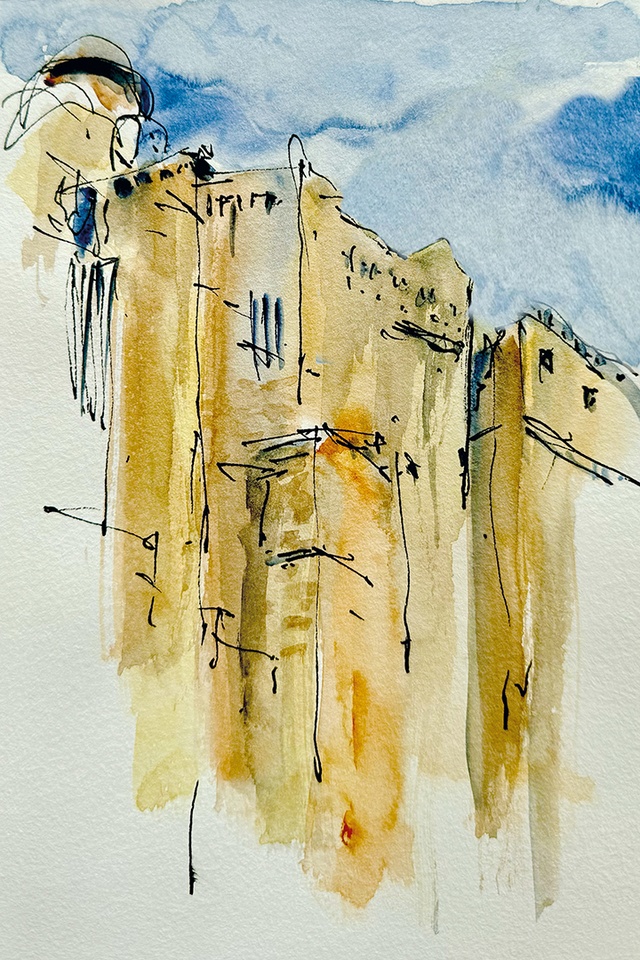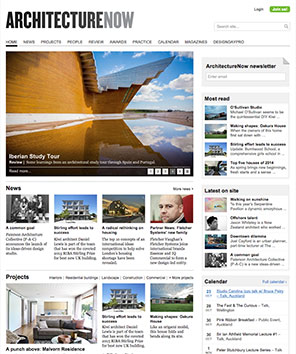The ramp
Pip Cheshire recounts a recent pilgrimage, including a trek up a dauntingly steep ascent to a centuries-old, crystalline castle in India.

The lift promised a free ride, halfway up inside the castle, we were told. Well, not really free, but a modest fee when weighed against the rising plane of uneven cobblestones lifting away to the right that was our only alternative. Our guide had warned of a long and arduous climb before reaching the entry above. Shimmering heat disturbances in the air from the mid-morning sun were a further disincentive to the overland schlep. My companion, who had previously exhibited all the energy of a hyperactive party-goer, spoke of a back suffering the consequences of a long tour and opted to join me in the mechanised option. And so we queued, joining a long line of supplicants snaking through the serried columns to the promised elevator.
The queue did not move. It was hot with still, dry air, the temperature in the mid-30s, and we began to speculate on the size of the carriage. Was it, perhaps, a small metal cage admitting one passenger at a time, threading its way through the shaft of a medieval latrine? Or was it some vast, aircraft-carrier-like hydraulic platform, taking an age to load but clearing the queue in one fell swoop? The unmoving queue suggested the former.
To while away the time as those around us chatted, laughed and surreptitiously included us in their photographs, I described Galfetti’s wonderful insertion at Bellinzona that whisked visitors up through the centre of the rock on which the castle stood. In doing so, it affirmed the civility of that canton and its pleasure in the potency of architecture, and of the confidence with which a thoughtful contemporary insertion might be made into a centuries-old and much-valued structure.
It was tedious standing, unmoving, at the end of the queue and, eventually, my companion and I decided to follow the rest of the party who, by that time, had headed upward, along a shallow incline, striding out in that annoying way the fit and able have when viewed by those struggling along behind. I was filled with trepidation at the thought of what lay ahead, as the stream of visitors disappeared up and around a stone abutment, amid the sound of massed footfall, erratic shrieking of crows and the concatenations of belated Diwali celebrations.
I steeled myself, put my best foot forward and felt the swivelling of my hard-worked ankle as it accommodated the rolling surface of pavers, polished by centuries of feet, elephant-borne maharajahs, court inhabitants, peasants and, I imagined, those laying siege to the castle above. I reached the end of the stone abutment and found myself on a loosely formed open plane tipping away from the castle’s mass. My heart dropped as I surveyed the ascent I had been warned of: a steeply sloping six-metre-wide ramp funnelling up, unleavened by the relief of landings and bounded by smooth, red stone walls that appeared to close and narrow the path as one ascended.
I was relieved to see I was not alone in my travails, the granite setts hosting a ragged collection of aged and infirm pilgrims slowly making their way up the incline. We were, for all the world, like detritus amid the fast flow of the young and fit, my rasping gasps for air adding to the shuffle of feet around me. I sought the assistance of the single handrail, using it to belay upward, one step at a time, pride gone in favour of progress and survival. The wall to which the time-polished handrail was affixed radiated a constant, searing, dry heat and bounced back the shuffle of feet, the happy instructions of those around me grouping their parties for selfies, and the swelling glissando sound of tabla and bhaya coming from somewhere up ahead.
Part way up that shimmering, paved skillet, I paused in the welcome shadow of an outer gateway arching overhead, sucking in the cooler air as if it were a draught from a mountain stream. Hoping to make my stop to recuperate appear a deliberate choice rather than one of basic survival, I peered through a gap in the outer wall and saw, far below, the intricate crenellations of a smaller and more-detailed structure we had visited only a short time before. Though scorched by sun and stone, I was calmed by the memory of my so-recent gentle walk on shaded grass pathways between marble ponds and finely carved memorials. I imagined, too, the sarangi’s melodious drone between the booming drum beat ricocheting off the robust enclosure of my current station. The memory was a balm for my flagging and dishevelled enthusiasm as I ventured back into the broiling heat of that unshaded ramp. I inched forward towards its abrupt end: a solid assembly of stone and brickwork, partially covered in crumbling plaster and supporting an arch some 10 metres above. The effect was a blind canyon such as I had seen in childhood Westerns in which the hero attempts to escape only to be trapped by a cruel topography offering no escape and falls prey to the pursuing baddies.
Unlike those desert traps, two enormous wooden doors covered with metal and the verdigris of centuries were revealed, recessed in the side wall and opening to the castle’s inner entry courtyard. It required little imagination to understand the purpose of the configuration of walls at the ramp’s end. Where that long upward ascent was overlooked by high ramparts with small apertures and cantilevered platforms from which arrows, boiling water and shot might rain down, the cul-de-sac compressed attackers, giving little room for gathering in numbers or the employment of siege machines to breach the gates. The crowd around me was, however, a benign lot, many still enjoying the Diwali holiday, but the compression of bodies under that high arch, and their jostling push towards the courtyard generated a turbulent commotion. For a moment, there was confusion, a hubbub accentuated by the almost total enclosure of the hard, flat stone walls within which drum, voice, laughter and, yes, my wheezing, gasping breaths, echoed and rebounded. One had little chance to rest in this narrow throat, though, and I was swept along with the rabble into the long courtyard within.
Where the massive, sculptured walls of the exterior approach were a language of exclusion and defence, the courtyard into which we were thrust was one of invitation and outlook. It was as if I had entered a geode through its defensive carapace and the crystalline interior suddenly exposed. Ahead of me lay a delicately articulated façade of dark, perforated wooden screens, cantilevered colonnades and belvedere interspersed with carved marble mashrabiya. There were, too, passageways ascending steps and offering glimpses of yet more courtyards within. I was transported from the belaboured ascent of a few moments ago to a consideration of a life gazing over the battlements to one’s surrounding territories, of labyrinthine passages filled with the murmur of intrigue, and painted and mirrored halls in which I am sure the faintest echo of generations of previous occupants’ sumptuous lives could still be heard, even above my slowing gasps.










